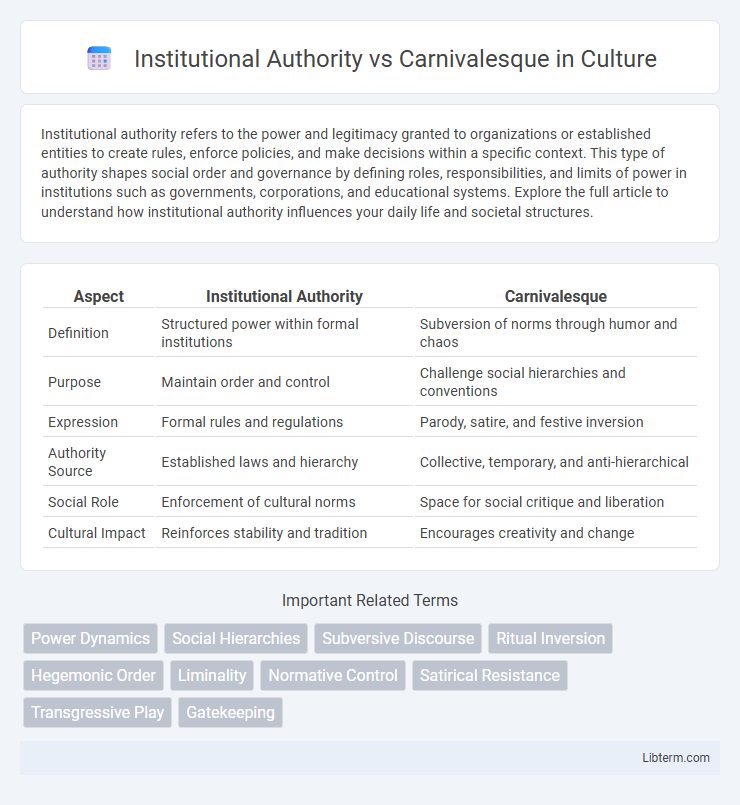Institutional authority refers to the power and legitimacy granted to organizations or established entities to create rules, enforce policies, and make decisions within a specific context. This type of authority shapes social order and governance by defining roles, responsibilities, and limits of power in institutions such as governments, corporations, and educational systems. Explore the full article to understand how institutional authority influences your daily life and societal structures.
Table of Comparison
| Aspect | Institutional Authority | Carnivalesque |
|---|---|---|
| Definition | Structured power within formal institutions | Subversion of norms through humor and chaos |
| Purpose | Maintain order and control | Challenge social hierarchies and conventions |
| Expression | Formal rules and regulations | Parody, satire, and festive inversion |
| Authority Source | Established laws and hierarchy | Collective, temporary, and anti-hierarchical |
| Social Role | Enforcement of cultural norms | Space for social critique and liberation |
| Cultural Impact | Reinforces stability and tradition | Encourages creativity and change |
Defining Institutional Authority: Structures and Power
Institutional authority embodies structured power dynamics embedded within formal organizations such as governments, educational systems, and religious institutions, which enforce rules and norms to maintain social order. This authority relies on hierarchical frameworks and codified regulations that legitimize control and decision-making processes over individuals or groups. The power exercised through institutional authority often manifests in bureaucratic procedures, legal mandates, and established protocols that sustain stability and compliance.
Understanding the Carnivalesque: Origins and Characteristics
The carnivalesque originates from Mikhail Bakhtin's theory, describing a literary mode where traditional structures of institutional authority are subverted through humor, chaos, and the grotesque. It features characteristics such as the inversion of social hierarchies, the suspension of normative rules, and the creation of a liberating communal space where alternative voices and marginalized perspectives flourish. This mode challenges dominant power by celebrating bodily excess, festivity, and dialogic interaction, disrupting established order and enabling critical reflection on sociopolitical norms.
Historical Contexts: Authority and Subversion
Institutional authority historically represents centralized power enforcing social norms through law, religion, and governance, embodying order and control over populations. Carnivalesque challenges this authority by creating subversive spaces where hierarchies are temporarily inverted through humor, chaos, and bodily excess, reflecting popular resistance. Rooted in medieval festivals and folktales, carnivalesque practices reveal societal tensions and allow marginalized voices to contest dominant ideologies without permanently dismantling institutional frameworks.
Language and Symbolism: Control vs. Chaos
Institutional authority employs formal, structured language and symbolic rituals to reinforce control and hierarchy, emphasizing order and conformity within social frameworks. Carnivalesque language subverts these norms through humor, parody, and grotesque imagery, destabilizing authority by celebrating chaos and inverted social roles. This clash between controlled symbolism and subversive expression highlights the tension between dominance and liberation in cultural narratives.
The Carnivalesque in Literature and Art
The carnivalesque in literature and art subverts institutional authority by embracing chaos, humor, and the grotesque to challenge established power structures and social norms. This concept, rooted in Mikhail Bakhtin's theory, celebrates liberation through role reversals, parody, and the suspension of hierarchical distinctions. Artistic expressions utilizing the carnivalesque create spaces where marginalized voices disrupt dominant discourses, fostering critical reflection and social change.
Social Order: Maintenance and Disruption
Institutional authority enforces social order through established laws and hierarchical structures designed to maintain stability and control. Carnivalesque subverts this order by temporarily dismantling social hierarchies, promoting chaos, humor, and free expression as a form of resistance. The tension between institutional authority and the carnivalesque reveals the ongoing negotiation between social maintenance and disruption in cultural and political contexts.
Public Spaces: Staging Authority and Carnival
Institutional authority in public spaces is staged through controlled environments, formal architecture, and regulated behavior that reinforce social hierarchies and power structures. In contrast, the carnivalesque disrupts these spaces by subverting norms, encouraging collective participation, and fostering temporary equality through humor, chaos, and performative reversals. This dynamic interplay transforms public spaces into arenas where power is both contested and reaffirmed, highlighting the tension between order and liberation.
Institutional Responses to the Carnivalesque
Institutional authority often responds to the carnivalesque by enforcing regulations that maintain social order and suppress subversive or chaotic expressions characterized by humor, role reversals, and transgression. These responses include legal restrictions, censorship, and the reinforcement of hierarchical norms to prevent destabilization of established power structures. Institutions also co-opt carnivalesque elements to neutralize their disruptive potential while preserving control over cultural narratives.
Contemporary Examples: Authority Challenged
Contemporary examples of institutional authority being challenged highlight the growing influence of the carnivalesque, seen in protests like the global climate strikes and digital movements such as #MeToo, which disrupt traditional power structures through humor, spectacle, and collective action. Social media platforms amplify these carnivalesque interventions by enabling marginalized voices to question and subvert established norms of authority in public discourse. These phenomena illustrate how symbolic carnivalesque acts erode institutional control, fostering participatory cultural spaces that redefine social hierarchy and challenge official narratives.
Balancing Control and Freedom: Future Perspectives
Institutional authority maintains social order through formal rules and hierarchical structures, while the carnivalesque challenges these norms by fostering freedom, creativity, and subversion. Balancing control and freedom requires dynamic frameworks that allow for regulated spaces where dissent and play can coexist with governance, ensuring adaptive resilience in evolving societies. Future perspectives emphasize integrating digital platforms and participatory practices to mediate institutional power and carnivalesque expression, promoting inclusive dialogue and democratic innovation.
Institutional Authority Infographic

 libterm.com
libterm.com